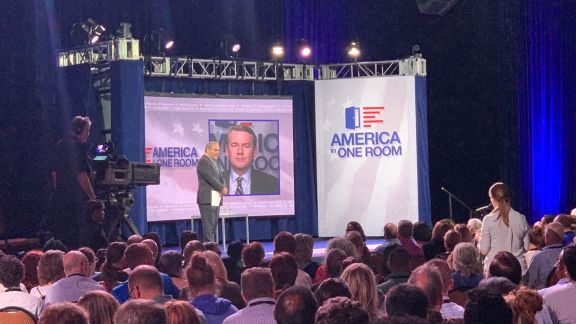Mode-Sequencing Insights from the General Social Survey
For inquiries, email:
September 2024
Multimode data collection methodologies can help address declining participation rates, rising costs, and other survey challenges.
However, the modes’ order can impact the survey’s effectiveness. This brief explores how the sequencing of push-to-web (PTW) and face-to-face (FTF) in a nationally representative survey may influence response rates, key trends, and overall costs.
In 2022, NORC at the University of Chicago fielded the General Social Survey (GSS) as a multimode study. Respondents were randomly assigned to one of two data collection sequences in an experimental design. The first sequence used FTF as the primary mode and then invited all nonrespondents to complete the survey on the web (FTF-first). The second sequence used PTW as the primary mode and then invited a subsample of nonrespondents to complete the survey in an FTF interview (web-first).
Our analyses found that both sequences produced comparable results, and neither achieved a better response rate. For costs, the web-first sequence was more cost-effective per completed interview, but the PTW follow-up in the FTF-first sequence increased response rates at a lower cost and did not require subsampling of nonrespondents.
Background
Survey designs that rely on multiple modes of data collection have become increasingly utilized in recent decades to address declining response rates and rising data collection costs (de Leeuw, 2018; Olson et al., 2021). Using multiple survey modes has also been shown to be more representative of the population than using a single mode (Cornesse & Bosjnak, 2018). While multimode studies are common, there are many unanswered questions about which designs are best for a given set of conditions (e.g., population of interest, survey topic, timeline). This includes which data collection modes to offer, whether to provide data collection modes concurrently or sequentially and, if sequentially, what order of mode administration would make the most sense.
Offering data collection modes in sequence can help improve response over a single mode alone by reducing coverage and nonresponse-related errors (Suzer-Gurtekin et al., 2018). Sequential designs also help to control survey costs. Less expensive survey modes (e.g., web) are typically used first in sequential designs to guarantee more cost savings (Wagner et al., 2014). However, long-established surveys that have historically utilized more costly interviewer-administered modes (e.g., face-to-face) may be hesitant to switch away from their traditional modes of collection because additional modes of administration can introduce new sources of survey error, such as sample imbalances or potential mode effects (de Leeuw, 2018). The introduction of web as the primary data collection mode could also impact measurement properties (i.e., changes in response distributions) in historically interviewer-administered surveys (de Leeuw, 2018). This brief will examine how the sequential ordering of web and face-to-face (FTF) modalities impacts response rates, demographic and attitudinal outcomes, and overall costs in a nationally representative survey: the General Social Survey (Davern et al., 2024).
The 2022 GSS Design
The General Social Survey (GSS) is a nationally representative, cross-sectional survey conducted since 1972. The GSS monitors public opinion trends by providing a core of demographic, behavioral, attitudinal, and topical questions. The GSS aims to provide high-quality research data with minimal costs and latency.
Survey data collection methods have evolved over the course of the GSS. For most of its 50-year history, GSS data collection has been based on area probability sampling methods, primarily FTF data collection methodologies, and a small number of phone interviews to aid with nonresponse. In response to the COVID-19 pandemic in 2021, the GSS shifted to a remote-only survey using mail push-to-web (PTW) and supplementing with telephone interviews where necessary. In mail-PTW (also known as web-push), a survey invitation is mailed to an address inviting them to complete the survey online (Dillman, 2017). Other large-scale studies, such as the American National Election Studies (ANES), have explored a similar approach with encouraging results (DeBell et al., 2018).
Learning from the 2021 GSS experience, NORC fielded the 2022 GSS as a multimode experimental study with both FTF interviews and web questionnaires as the primary modes of data collection, with a small number of supplementary phone interviews. More specifically, the 2022 GSS included a data collection sequence experiment transposing the order of FTF and PTW as the first mode of survey administration. The experiment sought to evaluate how best to combine FTF and PTW methods to minimize coverage, measurement and nonresponse error, and survey costs.
The mode assignment and nonresponse follow-up (NRFU) contact protocol was as follows (Figure 1). The GSS sample was randomly assigned to one of two experimental conditions, FTF-first or web-first, which determined whether participants would be offered an in-person interview or a web questionnaire first. In the FTF-first sequence, nonrespondents were offered the option to complete the survey online via the web. For the web-first sequence, only a subsample of nonrespondents (~20 percent) were offered the option to complete the survey in person. Telephone was used in both sequences at the interviewer’s discretion when it was deemed important to offer a telephone option.
Figure 1
Overview of GSS 2022 sequential design

Our Research
Our primary analysis examines the differences between the FTF-first and web-first completes. We compared both the full data collection sequence samples and the sample achieved by the first mode offered. For demographics, we used a two-sample test of proportions accounting for complex sample design and used pre-raking design weights to prevent such adjustments from influencing our conclusions. For substantive responses, we used a two-sample test of proportions accounting for the complex sample design. We used weights that accounted for nonresponse and adjusted to U.S. population estimates (i.e., raked weights). In total, we examined 177 attitudinal variables across a range of subject domains, selecting a subset of the most common and popular GSS Data Explorer variables.
Findings
Response Rates & Response Modes by Experimental Condition
Overall, both full data collection sequences achieved around a 50 percent weighted response rate (AAPOR RR3; AAPOR, 2016; Davern et al., 2024). The web-first condition (whose NRFU mode is F2F) obtained 2,004 completes compared to 1,540 for the FTF-first condition (which has an NRFU component based on a web survey) (Table 1).
Table 1: Response rates and response modes by experimental condition
| Response Mode | Web-First Sequence | FTF-First Sequence | Total Completes | |||
|---|---|---|---|---|---|---|
| n | % | n | % | n | % | |
| Web | 1,208 | 60% | 428 | 28% | 1,636 | 46% |
| Face-to-Face | 619 | 31% | 954 | 62% | 1,573 | 44% |
| Phone | 100 | 5% | 106 | 7% | 206 | 6% |
| Mixed Mode | 77 | 4% | 52 | 3% | 129 | 4% |
| Total Completes | 2,004 | 1,540 | 3,544 | |||
| Sampled Households | 11,168 | 3,844 | 15,012 | |||
| Response Rate | 50.8% | 49.9% | 50.5% | |||
Note: Column percentages by data collection sequence are unweighted. Weighted response rates are calculated using WTSSNRPS excluding AmeriSpeak oversample cases and are AAPOR RR3.
The web-first condition achieved this higher number of completes while achieving an equivalent response rate, but it did require far more sampled households to do so. Between the two sequences, we saw that most respondents completed the survey via the first mode offered. Sixty percent of the web-first sample completed via the web, whereas 62 percent in the FTF-first sequence completed an FTF interview. Approximately 30 percent of respondents completed in the NRFU mode (i.e., web survey for FTF-first or FTF intervewing for web-first). About 5 to 7 percent completed on the phone. Less than 5 percent used a combination of survey modalities (e.g., people starting the survey F2F and finishing on the phone).
Demographic Characteristics by Experimental Condition
For demographic analysis, we compare responses obtained with the first mode offered in each sequence (i.e., either web or FTF) prior to the NRFU. In that comparison, we see nine significant differences between the two experimental conditions in relation to the respondent’s race, education, marital status, and the number of adults in the household (Figure 2, Panel A). Succinctly, the web completes from the web-first experimental condition include more white, college-educated, and married respondents and three or more adult households relative to the F2F-first condition.
When we compare demographics for the two experimental conditions, including NRFU cases (that is, when we compare the full data collection sequences), there was only one significant difference in demographics (Figure 2, Panel B). The full web-first sequence saw more households with three or more adults than the full FTF-first sequence. The differences previously observed for race, education, and marital status all come within about 2 percentage points between the two sequences, which can be attributed to sampling error. Overall, adding the nonresponse follow-up to each experimental condition (either F2F or web) significantly helped to balance each sample so that they were more similar.
Figure 2
Adding the nonresponse follow-up (NRFU) to each experimental condition helps balance each sample.

Survey Responses by Experimental Condition
When we analyze attitudinal data as if it were a single-mode study (i.e., excluding NRFU cases collected in the secondary survey mode), we find that response distributions are not equivalent. Looking at 614 response categories (of 177 variables) after only the first mode of each sequence (Figure 3, Panel A), there are large differences between web-first and FTF-first. While the middle half of the differences presented in the analysis without NRFU cases are within 3 percentage points, there are many other survey questions with differences above 10 percentage points. However, when cases collected as part of NRFU are added to the analysis (Figure 3, Panel B), the estimates between the two sequences suggest far more comparable results, with 83 percent of differences within 3 percentage points. The reduction in the range of differences shows how introducing the NRFU modes helps to minimize differences between the two sequences.
Figure 3
Introducing the NRFU modes helps minimize differences between sequences.

To further illustrate this last point and to make estimate differences more comparable, we standardized survey response differences (Figure 4). Adding the second data collection mode at the NRFU stage reduced the number of significant differences. When examining the estimates with only the initially offered mode, 30 percent of the individual-level responses were statistically different at the 0.05 alpha level. In contrast, less than 4 percent of response differences were significantly different when we considered the full data collection sequence, which is just as likely by random chance at an alpha level of 0.05 percent.
Figure 4
Adding the second data collection mode at the NRFU stage reduced the number of significant differences.

Relative Costs
While the sequence order of web and FTF minimally impacts the difference in attitudinal estimates or demographic composition, the order of survey mode does impact costs. Our cost modeling found that the cost per completed interview for an FTF-first complete is about 50 percent larger than the cost per completed interview for a web-first complete.
Accordingly, the web-first sequence proved more cost-effective than FTF-first obtaining 60 percent of completes by the most affordable survey mode. Adjusting for the greater number of completes in the web-first condition results in an over 30 percent relative cost savings compared to the FTF-first condition. The PTW follow-up for nonrespondents in the FTF-first sequence significantly increased the response rate at a lower cost than the historical in-person follow-up. These results illustrate that the optimal data collection sequence is a function of the relative costs of PTW and FTF based on fixed set-up costs and variable costs per case.
Discussion
The findings of this experiment showcase the promise of push-to-web (PTW) or face-to-face (FTF) data collection sequences for large-scale studies, such as the General Social Survey. The comparability in weighted response rates, demographic composition, and survey estimates suggest that the data collection sequence of PTW and FTF has minimal impact on survey participation or attitudinal estimation when a full multimode sequence is used.
Despite the similarities in both sequences, we did observe some differential benefits for each sequence. The FTF-first sequence was able to make effective use of a more affordable data collection mode (i.e., web surveys) for all nonrespondents, which did not require subsampling for nonresponse follow-up, simplifying statistical weighting. The web-first sequence, however, minimized early data collection costs by obtaining a majority of final responses quickly and reducing the need for in-person follow-up. However, the web-first design required subsampling of cases to reduce data collection costs for the nonresponse FTF interviewing. In the case of the 2022 GSS, about 20 percent of nonrespondents were subsampled for follow-up. Adjusting the subsampling rate of a nonresponse follow-up could change the cost of in-person data collection.
Due to some difficulty in recruiting field staff in some locations, the FTF-first sequence needed to expedite the PTW nonresponse follow-up for some cases. This limited the extent to which the FTF completes could be obtained in this sequence but did facilitate swifter completion in understaffed areas. The final analytic weights adjust for area nonresponse, correcting these differences.
Combining web and FTF seems to improve cooperation by obtaining people with different characteristics regardless of ordering in mode sequence. This finding supports previous work on how multimode surveys improve demographic representation. While our work touches on this, more research should be done to understand the selection mechanisms and more fully consider how multimode sequences might change sampling composition and key trends relative to single-mode studies.
Conclusion
Multimode studies need to be carefully designed and coordinated. Our findings from the 2022 GSS mode sequence experiment show that costs can be minimized without significant impacts on data quality while utilizing different variations of web and FTF sequential data collection methodologies. The 2022 GSS experiment and corresponding analysis further support the benefits of surveys that include nonresponse follow-up leveraging multimode survey designs. The 2024 GSS is designed to replicate the 2022 experimental design, enabling a future examination of whether the design produces consistent results at two time points.
References
- The American Association for Public Opinion Research (AAPOR) (2016), Standard Definitions: Final Dispositions of Case Codes and Outcome Rates for Surveys (9th ed.). Oakbrook Terrace, IL, USA: AAPOR. https://aapor.org/wp-content/uploads/2022/11/Standard-Definitions20169theditionfinal.pdf
- Cornesse, C., & Bosnjak, M. (2018). Is there an association between survey characteristics and representativeness? A meta-analysis. Survey Research Methods, 12(1), 1-13. doi:10.18148/srm/2018.v12i1.7205 https://doi.org/10.18148/srm/2018.v12i1.7205
- Davern, M., Bautista, R., Freese, J., Herd, P., & Morgan, S. L. (2024). General Social Survey, 1972-2022 (Release 3a) [Data set and code book]. NORC. https://gss.norc.org/Documents/codebook/GSS%202022%20Codebook.pdf
- DeBell, M., Amsbar, M., Meldener, V., Brock, S., & Maisel, N. (2018). Methodology report for the ANES 2016 time series study. Palo Alto, CA, and Ann Arbor, MI: Stanford University and the University of Michigan. https://electionstudies.org/wp-content/uploads/2016/02/anes_timeseries_2016_methodology_report.pdf
- de Leeuw, E. D. (2018). Mixed-mode: Past, present, and future. Survey Research Methods 12(2), 75-89. https://doi.org/10.18148/srm/2018.v12i2.7402
- Dillman, D. A. (2017). The promise and challenge of pushing respondents to the web in mixed-mode surveys. Survey Methodology, 43(1), 3-30. http://www.statcan.gc.ca/pub/12-001-x/2017001/article/14836-eng.htm
- Suzer-Gurtekin, Z. T., Valliant, R., Heeringa, S. G., & de Leeuw, E. D. (2018). Mixed-mode surveys: Design, estimation and adjustment methods. In T. P. Johnson, B. Pennell, I. A. L. Stoop, & B. Dorer (Eds.), Advances in Comparative Survey Methodology (pp. 409-430). John Wiley & Sons, Inc.
- Wagner, J., Arrieta, J., Guyer, H., & Ofstedal, M. B. (2014). Does sequence matter in multimode surveys: Results from an experiment. Field Methods, 26(2), 141-155. https://doi.org/10.1177/1525822X13491863
Acknowledgements
We would like to thank NORC’s Methodology and Quantitative Social Sciences Department for supporting this report. We would like to thank Pamela Herd and Stephen Morgan for reviewing the brief, Zachary Seeskin for the cost information, and Akari Oya for assisting with last-minute analyses. Finally, we would like to thank Colm O’Muircheartaigh, Ned English, and Steven Pedlow, who included elements of this research in a presentation for the 2023 European Survey Research Association (ESRA) Conference. This experiment was conducted with the National Science Foundation grant award 2049169.
About NORC at the University of Chicago
NORC at the University of Chicago conducts research and analysis that decision-makers trust. As a nonpartisan research organization and a pioneer in measuring and understanding the world, we have studied almost every aspect of the human experience and every major news event for more than eight decades. Today, we partner with government, corporate, and nonprofit clients around the world to provide the objectivity and expertise necessary to inform the critical decisions facing society.
Contact: For more information, please contact Eric Young at NORC at young-eric@norc.org or (703) 217-6814 (cell).






